volume10 1940-1941
| série: | Tarzan Sunday Pages |
| dessinateur / scénariste: | Hogarth Burne |
| éditeur: | Flying Buttress EO 1995 |
| genre: | Aventure |
| classement: | biblio1 |
| date: | 1995 |
| format: | cartonné avec jaquette |
| état: | TBE |
| valeur: | 30 € |
| critère: | **** |
| remarques: | tenth volume edited by NBM/Flying Buttress (NBM being America's first publisher of graphic novels since 1976, located at New York with imprints such as Flying Buttress Classics Library, Amerotica, Eurotica and ComicsLit) under the supervision of Bill Blackbeard out of a sery of 18 volumes, all being accurate reproduction of the Sunday Pages in their full colour and in full size, each volume has about 52 pages, n.b. the sources of these Sunday pages are mainly from the Los Angeles Times and from the Milwaukee Journal edited by UFS (United Features Syndicate) volume 10 1940-1941 with dust jacket from 15.9.1940 (497) to 7.9.1941 (548) = 52 pages drawn by Burne Hogarth, based based on the novel of Edgar Rice Burroughs Tarzan rescues the Fire People's crown prince Tanny from the evil priests of the Sea Peoples only to find that the King of the Fire People has been overthrown by the evil Towrit later, volcanic eruptions followed by tidal waves lay waste both civilizations in a dazzling display of Hogarth's dynamic artistry, the volume includes following episodes (number of pages): - Peoples of Sea and Fire part two: 32 - Tarzan against Dagga Ramba part one: 20 1/ introduction Rubimorass (comments about Rubimor) the editor did not intend to publish the entire strips of Ruben Moreira alias Rubimor, this due to his lack of talent, the editor was however requested by many readers not to skip Rubimor's strips (769 to 856 = 88 pages drawn 1946/1947) and also to introduce some pages from Lubbers (the unique page 772 of 1945 and some pages ending a Tarzan's episode (pages 1016 up to 1019 in 1950) n.b. the letter of Clarence Hyde, president of the Burroughs bibliophiles pleading for the Rubimor's pages to be published 2/ peoples of the sea and fire, part two (497-528) on his escape with Tanny, Tarzan finds refuge at princess Leecia's but looking for an exit in the city walls, Tarzan is recaptured and brought to Molocar, Tarzan escapes again and now succeeds in leaving the city with Tanny and Leecia; shortly afterwards, they meet some soldiers of the city of fire who make them prisoners, Tanny's father having been slain by Towrit, the villain usurpator, Tarzan can escape with Tanny, but Leecia remains in the hands of the soldiers >> p. 501 the warriors of the city of fire armed with flaming swords whose blade is covered with burning resine n.b. the soldiers of the city of sea are clean-shaven whereas the soldiers of the city of fire bear beard and moustache! on his flight, Tarzan enters the demon's cavern and is attacked by a mysterious creature who proves to be Jaxie, the bodyguard of Tanny's father, hiding from Towrit in the demon's cave >> p. 504 fight of Tarzan against the giant gnome Jaxie meanwhile Leecia is brought before Towrit, the new cruel king of the fire peoples, on his side Tarzan in the cavern discovers that the volcano near the city of fire is soon to explode and he decides to save Leecia without delay as she has been condemned to be offered as a sacrifice to the fire-god being the volcano n.b. Baal-Yeom is the god of the sea-peoples and Baal-Yek the god of the fire peoples >> p. 505-510-511-512 the villain Towrit drawn with his horrible face >> p. 508 Tarzan playing catapult in order to cross the flaming wall of the city of fire; however on entering the city, Tarzan is captured and brought with Leecia to the fire-god on the brink of the crater, Tarzan succeeds in throwing Towrit into the flame of the volcano and putting confusion among the soldiers, he escapes with Leecia rejoining Tanny and Jaxie while at the same moment, the volcano burst into full explosion destroying the fire city >> p. 515 the titanic explosion bringing the volcano in full eruption >> p. 516 the destruction of the city of fire luckily all four friends can leave unscathed the city of fire, but they are followed by a storm of molten lava, Leecia proposes to take shelter in the city of sea but Tarzan replies that it would also become a tomb, on Leecia's request Tarzan goes to warn the sea peoples of the danger of the tidal wave, but he is captured again by Molocar and again sentenced to death, however when the great tidal wave hits the city, Tarzan escapes again leaving Molocar and his priests to their fate of death >> p. 523/524 the destruction of the city of sea and the escape of Tarzan among the lethal tidal waves (see picture annexed) >> p. 524 again a superb illustration >> p. 527 is Tarzan really so mighty? >> p. 528 a situation practically not possible as the lava coming into the water would boil the peoples having taken refuge in the water with Prince Tanny and Leecia rescued, Tarzan organises now the reconciliation of the sea and fire peoples and leaves them by sailing on the sea to an unknown destination >> this episode is one of the best created by Hogarth, the action is thrilling and original with practically all pages beautifully drawn 2/ Tarzan against Dagga Ramba, part one (529-548) on his way home through the desert, Tarzan meets a caravan of strangers and saved the life of princess Ta'ama who is on the way from Istamboul to reach the kingdom of her father, the emir of Soufara, from the attack of a fierce leopard, however stunned by this fight, Tarzan would have been killed by sheik Numali, had not Ta'ama intervened in favour of Tarzan, Ta'ama asks then Tarzan to accompany her during the desert crossing, but sheik Numali has now become jealous and vows vengeance on Tarzan >> p. 530/531 the veiled girl on a camel's canopy and Tarzan fighting again a furious leopard >> p. 532 the beauty (Ta'ama) and the beast (Numali) on its way, the caravan is halted by a group of Askaris who will take them as prisoners to the fortress of Dagga Ramba, the emperor of the mountains and of the desert >> p. 533 Dagga Ramba quite similar to a kind of a black Mussolini (we are in the year 1941 with the war extended to North Africa) >> p. 534 Tarzan misled by the Askaris has a special treatment for their treachery Tarzan of course escapes at the first opportunity but promises to Ta'ama to come again to deliver her, meanwhile Tarzan is attacked by a giant warrior who proves to be Kamur the Ibek also on the trail of his beloved Nikotris kept also captive in the fortress of Dagga Ramba, Tarzan penetrates into the fortress and succedd in handing Nikotris over to Kamur, but he is captured by the Askaris and brought to Dagga Ramba who condemns Tarzan to the gallows >> p. 538 the two women for whom Tarzan has to care for, first Nikotris then Ta'ama who is left behind and become jealous, whereas Tarzan tossed Nikotris over the rempart to the giant (an action drawn in two vignettes which is a Hogarth's typical construction for his dynamic style) >> p. 540 the fight between Tarzan and Dagga Ramba however before being hung, Tarzan escapes from his executioner and rejoins his Ibek friends whereas Dagga Ramba takes Numali as ally in order to ask the Iberks to surrender because Dagga Ramba has by now captured their king Kornak and threatens to execute the king if the Ibeks do not obey but Kornak prefers death to dishonour and is shot down while trying to run away n.b. king Kornak is shown now as a more honorable king contrary to his attitude in the previous episode (see volume 3 the Egyptian saga by Hal Foster) >> the story with Dagga Ramba is not as deeply elaborated as the one with the people of sea and fire, but the illustrations are again marvellous and this volume is one of the best of the whole serie n.b. for the first time in this volume, Hogarth experiences vignettes of different sizes - on full-width page as drawn before (see p. 526) but now new - on vertical strips (see p. 507, 513, 514) and - on large vignette involving four small vignettes (see p. 515, 516, 523, 524) and this new kind of artistic graphic shall continue throughout the next Tarzan's adventures, Hogarth being now at the peak of his artistry |
| couvertures: | 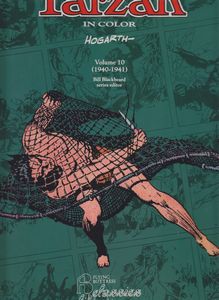 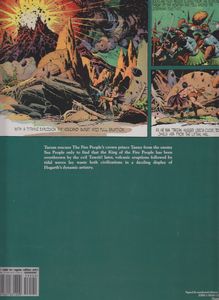 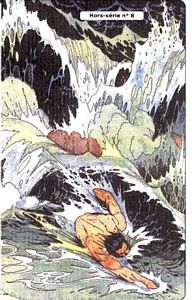 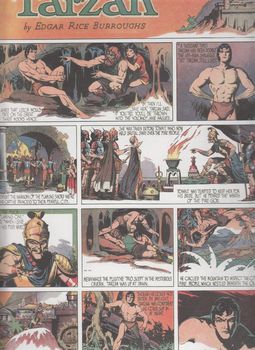 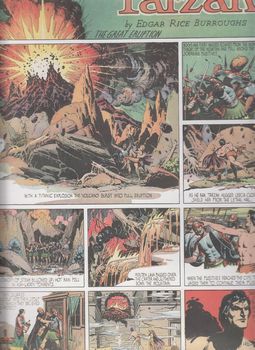 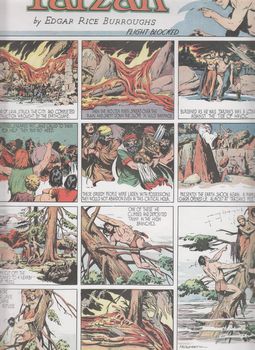 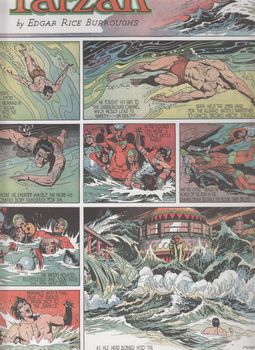 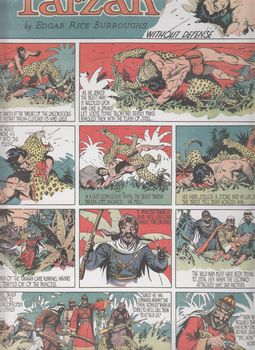 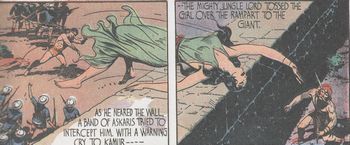 |
Copyright 2008 - 2025 G. Rudolf
